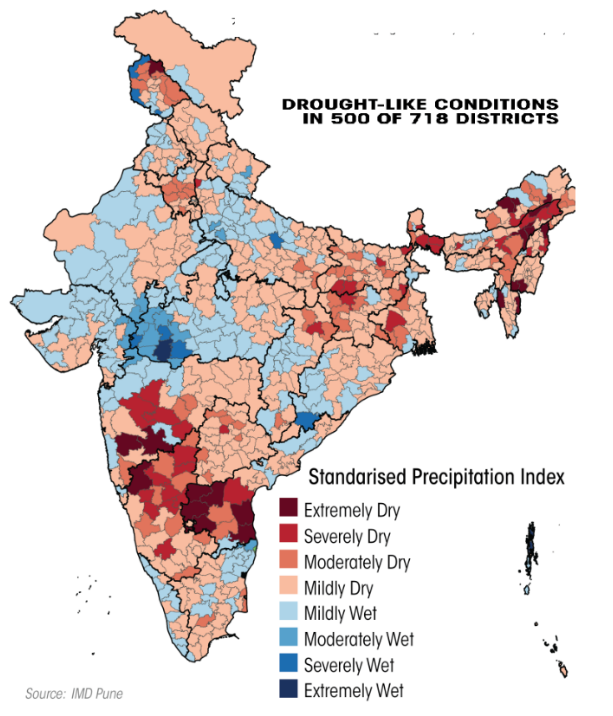| Global Security Initiative (GIS) | Recently, Nepal rejected calls from China to join the ‘Global Security Initiative (GSI)’, during the visit of Prime Minister Pushpa Kamal Dahal Prachanda to Beijing.
|
| RoDTEP (Remission of Duties and Taxes on Exported Products)) Scheme | Recently, the union government has extended support under the scheme for Remission of Duties and Taxes on Exported Products (RoDTEP) till 30 June 2024.
|
| Lithium Reserves in India
|
Indian government to auction lithium reserves in the Union Territory of Jammu & Kashmir soon.
About: Lithium
After J&K, Lithium reserves were also discovered on Revant hill in Degana in Rajasthan’s Nagaur district (In GSI Survey). These can meet 80% of the country’s demand. |
| Social Bonds | National Bank for Agriculture and Rural Development (NABARD) said it has issued its first rupee-denominated AAA-rated social bonds with a total size of ₹1040.50 crore.
About: Social bonds
NABARD: NABARD is a Development Bank with a mandate for providing and regulating credit for the development of agriculture, small-scale industries, cottage and village industries, handicrafts and other allied economic activities in rural areas to promote the prosperity of rural areas. |
| Dadasaheb Phalke Award 2023 |
About: The Dadasaheb Phalke Award
|
| Relevancy for Prelims: Indo Pacific Region, 13th Indo-Pacific Armies Chiefs’ Conference (IPACC), SAGAR, Act East policy, United Nations Convention on the Law of the Sea (UNCLOS), Indo-Pacific Economic Framework (IPEF), and QUAD.
Relevancy for Mains: Indo-Pacific Region and Its Importance, India’s Indo-Pacific Strategy, What are the territorial disputes in the Indo Pacific region and What are major groupings in the Indo-Pacific region? |
|---|
| What are the territorial disputes in the Indo Pacific region?
Tensions over competing territorial claims have the potential to escalate and disrupt regional stability in the Indo Pacific Region;
|
|---|
What are major groupings in the Indo Pacific region?
|
|---|
Also read: Drug Trafficking in India
The Indo Pacific region is undeniably a complex web of interdependencies, where geopolitical, economic, and security concerns intersect. As highlighted in this article, it’s a region of immense strategic importance due to its economic vitality and critical maritime routes. The countries in the Indo Pacific region should have equal access to the use of common spaces on water and in the air that would require freedom of navigation, economic resources and peaceful settlement of disputes in accordance with international law.
| Attempt the PY Prelims Question:
Q. India is a member of which among the following? (2015)
Select the correct answer using the code given below: (a) 1 and 2 only Ans: (b) Attempt the Mains Question: The new tri-nation partnership AUKUS is aimed at countering China’s ambitions in the Indo-Pacific region. Is it going to supersede the existing partnerships in the region? Discuss the strength and impact of AUKUS in the present scenario. (GS Paper 2: UPSC Mains 2021) |
|---|
Other Major Bodies of the UN are:
|
|---|
The UNGA is the only universally representative body of the United Nations.
What is an Unlisted Company?
|
|---|
Angel tax is the tax levied on the capital raised via the issue of shares by unlisted companies if the share price of issued shares is seen in excess of the fair market value of the company.
Startups tend to lose a significant amount of money in the form of taxes as angel tax requires them to share a significant part of the investment.
Does not account for externalities: India’s GDP does not consider the impact of industries on the environment and social welfare. Environmental experts have argued for the inclusion of such damage to the GDP.
Context: Over 500 of India’s 718 districts are currently reporting meteorological drought conditions, indicating a Standardised Precipitation Index (SPI).
Analysis of Data:

Reasons for Drought
Impact: Nearly two-thirds of the country is vulnerable to drought. There is an upward trajectory in the duration of droughts and the severity of impacts, not only affecting human societies but also the ecological systems.
News Source: Down To Earth
| Relevancy for Prelims: Supreme Court, Constitutional Provisions for appointment of judges, Procedure of Appointment of Judges, Collegium system, and Evolution of Collegium system.
Relevancy for Mains: Appointment of Judges in Higher Judiciary, Judiciary is experiencing an unprecedented loss of fresh talent due to prolonged delays in government decisions, and Cases related to the appointment of Judges in higher judiciary. |
|---|
Constitutional Provisions for appointment of judges
|
|---|
National Judicial Appointments Commission (NJAC)
|
|---|
International Practices of Appointment of judges
|
|---|
To remain an Independent and fair judiciary, it is important to address all current challenges related to the appointment of judges in the higher judiciary in India. To avoid this conflict the Government and Courts should work together to safeguard the integrity and independence of the Indian judiciary, ultimately in delivering speedy justice that reflects the hopes and values of our society.
| Attempt the PY Prelims Question:
Q. With reference to the Indian judiciary, consider the following statements: (2021)
Which of the statements given above is/are correct? (a) 1 only Ans: C Attempt the Mains Question: Critically examine the Supreme Court’s judgement on ‘National Judicial Appointments Commission Act, 2014’ with reference to appointment of judges of higher judiciary in India. (GS Paper 2: UPSC Mains 2017) |
|---|
SC Verdict on Newsclick Shows Adherence to Due Pro...
Stay Invested: On Chabahar and India-Iran Relation...
Credit Rating Agencies, Impact on India’s De...
Catapulting Indian Biopharma Industry
Globalisation Under Threat, US Import Tariffs Have...
Global Report on Hypertension, Global Insights and...
<div class="new-fform">
</div>
